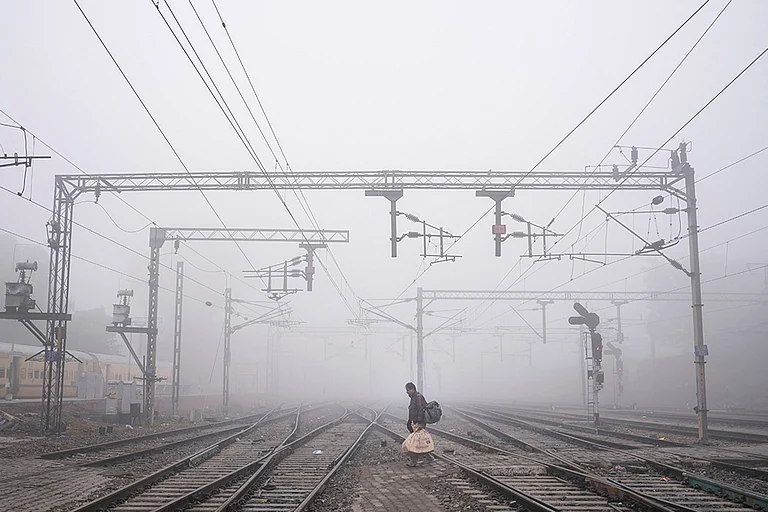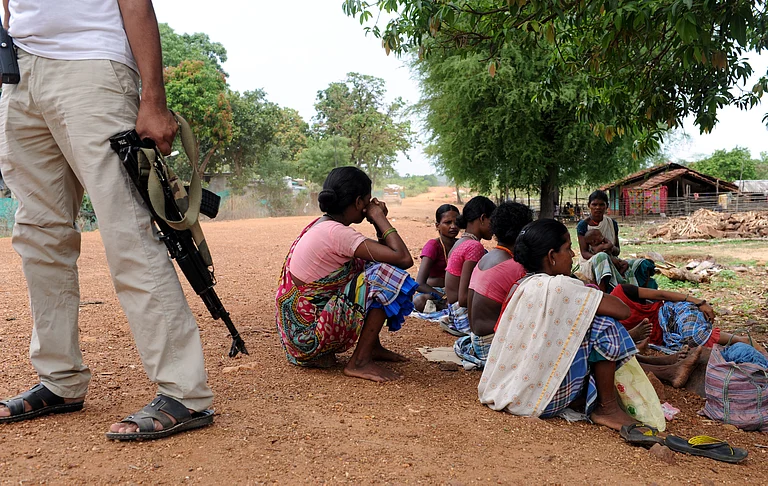For residents of Rampur Halwara, fear looms large. The worry about having their generational homes razed to the ground is growing as Ayodhya’s “ambitious” solar power plant project expands to their thresholds.
In August last year, Rampur Halwara village in Ayodhya district was declared as the site for a 40 megawatt solar power plant project to accommodate Ayodhya’s growing power demand. The project, which is a collaboration between the state government and NTPC Renewable Energy Limited is spread across 165 acres with over one lakh solar panels being installed.
About 30 to 35 families, mostly Dalits, reside in the area designated for the project. Many of them are now displaced due to their homes being torn down. The last lot of about a dozen houses remains.
Today, Rampur Halwara village has thousands of solar panels spread across acres of land with a select few chappars and pakka houses on the edge of the expanding solar project. Amid mounds of sand and gravel sits a faded yellow board which reads, “40MW Solar Power Project Ayodhya UP”. According to residents, hundreds of decades-old trees that once lined the road have been felled in the past few months leaving the region devoid of greenery. When the wind blows, it scatters the loose soil creating mini dust-storms.

Rampur Halwara resident Prakashini Kumari says that since the project began about six months ago, she’s witnessed many chappars being demolished without any notice or compensation. The displaced residents, she says, have either moved to their relatives’ houses in other villages or are setting up camp in a new location daily, after their pleas to not bulldoze their homes fell on deaf ears.
“They had no notice or written order to show to the people whose houses they tore down. The same will happen with us soon,” she says. “We have all the papers for our land but we don't know if that’ll save our house from being bulldozed.”
Prakashini's father-in-law, who was born in Rampur Halwara and had lived here for 85 years, passed away about a month ago due to the stress of losing his house, which contributed to his declining health. “We are always living in fear. We don't have any money or savings to be able to relocate. We barely make Rs 250 a day. With that, do we buy food, fund our children’s education or pay for other living expenses?” the mother of three said. "When we ask them if we will be given any compensation or allocated another piece of land, they say nothing. We are even ready to build a house in the khalia (ditch) but they don't say anything clearly,” she added.

Two houses down, Vineetha, a frail-looking woman in her forties, sits on a charpoy in front of her pakka house which she says she built about six years ago. “I received about Rs 3.5 lakh from the government under the Lohia Awas Yojana six years ago and now they want to take it away from us?” she asks. “They say we will get some compensation but people who’ve had their houses torn down haven’t received anything so I'll believe it when I get it.”
Vineetha says it had taken a lifetime to be able to “fulfill her dream” and build a pakka house with the help of the scheme, and if her house is demolished, it would not be possible for her to do it again.

About two months ago, 18-year-old Govind Majhi’s chappar was demolished. He and his family didn’t receive any notice or prior intimation and were given just a couple of hours to remove their belongings before their chappar was razed to the ground. Govind’s father Om Prakash Majhi had lived in the house for over 35 years but he couldn’t produce papers to plead his case before the authorities. “No one was listening to us because we didn’t have papers, so we have just accepted it,” he says. Govind’s farm lands have also been allegedly occupied by National Thermal Power Corporation Ltd (NTPC) for the project. “We used to get about Rs 30 to 35 thousand annually from wheat and Rs 1.5 lakh from sugarcane farming on those lands but now even that is gone.”
Govind’s father passed away a month ago and he now lives with his relatives in the city.
Ram Sabad Majhi, another resident and owner of the few pakka houses in the locality, has also lost about 12 bigha (roughly 8 acres) of farm land to the solar power plant project. “We had documents for the property but it was still taken,” Ram says. “They’ve told us that the land has been declared unfit for cultivation on account of being submerged.”
The same “submerged” land, however, is being used to mount solar panels. “And we didn’t even get any compensation for it,” he said. “In 1998, when a road was built cutting across our farm lands, we were all paid a compensatory amount. Now, when the entire property has been seized, why no compensation?”
When Majhi heard that his house was in the way of the project and would have to be demolished, he paid a visit to the DM Nitish Kumar’s office. “I visited the DM’s office about two months ago and was told no houses would be demolished before a survey is conducted,” he says. “Since then, no one has said anything about demolition but now the project has advanced to our boundary, very soon, it’ll be time for us to leave our house.”

Ayodhya DM Nitish Kumar told Outlook that compensation would be paid to all those affected—those who lost their property or their home. “We have written to NTPC saying that they need to compensate those with houses on government land before they demolish them. A survey is also ongoing to see how many people reside in the village and who will be affected. The villagers probably don’t know about this so they are worried,” he said.
Outlook sent a questionnaire to NTPC regarding the displacement and compensation to the villagers but did not receive any response.
This project is a part of Uttar Pradesh's ambitious Solar Energy Policy 2022 in which the plan was to develop 16 municipal corporations and Noida as solar cities. Ayodhya was supposed to be the model for other cities.

Since the consecration of the Ram temple earlier this year, Ayodhya has become a tourist hotspot, with several new hotels popping up and real-estate projects being sanctioned. The temple town has emerged as a new investment destination, attracting interest from a wide range of stakeholders, including hoteliers, airlines, and corporations. Due to this economic boom and development, there is an increasing demand for energy in Ayodhya, hence the solar power plant project.
Dalit activist and writer Bhanwar Meghwanshi says the poor, dalits, tribals, and minorities have always been displaced in the name of development, but now, these instances are increasing in the name of nation, development, and religion. “I believe that if those who talk about building Ram's house have no hesitation in destroying the houses of Dalits and the poor, then it proves where Dalits stand in this nation,” he points out. “For us, we have rights only as long as democracy and the Constitution are alive, otherwise we will be forced to live as homeless and destitute people. We have no place in such a nation.”
(with inputs from Jay Ganatra and Tusshar Yadav)




























